Abstract
Identifying oil migration through tectonic fractures in stable cratons is always challenging due to limited technical approaches. Here, we provide a case study showing that combined geochemical and geological analyses are a robust tool for identifying oil vertical migration through tectonic fractures. The core samples and crude oils from the Mesozoic petroleum system in the Zhijing area were investigated by an integrated analysis including petrography, biomarkers, nitrogen compounds, and spatial distribution. The tectonic fractures in the Yanchang Formation (YcF) are more developed compared to the Yan’an Formation (YaF), influencing oil migration patterns and reservoir distribution. Eighty-one percent of the tectonic fractures are filled with calcite cement, while only two percent of the tectonic fractures contain solid bitumen. The YaF and YcF oils originating from the same oil source are at the same maturity level. However, the YaF oils exhibit disordered nC18- distribution and “mismatches” at n-undecane and a decrease in toluene/n-heptane ratios, which resulted from the phase fractionation caused by the vertical migration through tectonic fractures. The spatial distributions of 1/4-MC, 1,8/2,7-DMC, and Ts/Tm values in the YaF oils are irregular. Furthermore, the areas occupied by the YaF oil reservoirs exhibit an absence of YcFs, and vice versa. These distribution patterns can be explained by oil vertical migration through tectonic fractures. A series of pieces of evidence indicates that the oils migrated vertically through tectonic fractures to the YaF. This study offers new insights into the oil migration process within the Mesozoic petroleum system of the central Ordos Basin and serves as guidance for identifying oil migration through tectonic fractures in stable cratons.
1. Introduction
Subsurface fractures significantly enhance storage capacity and permeability while influencing hydrocarbon migration and accumulation [1,2,3,4,5,6,7,8]. Consequently, fractures have attracted increasing attention in hydrocarbon exploration and reservoir development. Previous studies have extensively investigated fractures and have gained significant insights into (1) fracture identification and characterization [9,10], (2) the controlling factors of fracture formation [5,11,12], and (3) the effectiveness of fracture systems [7,13,14,15,16]. However, technical methods for definitively confirming or tracing hydrocarbon migration through fractures are limited. Aside from the observation of bitumen filling fractures and hydrocarbon-bearing inclusions trapped in veins [17,18,19], few geological or geochemical approaches to identify hydrocarbon migration through fractures have been reported.
The Mesozoic petroleum system in the Ordos Basin (Figure 1a) is mainly comprised of the upper Triassic Yanchang Formation (YcF) and the middle Jurassic Yan’an Formation (YaF) (Figure 1b). In this petroleum system, the distribution of YaF oils has been considered to be controlled by the pre-Jurassic paleo-river channels [20,21,22,23,24,25]. The paleo-rivers down cut the YcF, and the sand bodies filling the channels directly connected with the YcF sand bodies. The oils were expected to migrate from the underlying YcF into the overlying YaF through the connected sand bodies and finally accumulated in the traps along the paleo-rivers [22,26,27] (Figure 2). Thus, the pre-Jurassic paleo-river channels and their surrounding areas have always been the target areas for YaF exploration. In recent years, however, exploration failure is happening with increasing frequency in these target areas, and numerous “small but oil-enriched” YaF oil reservoirs were discovered in the areas far from the paleo-rivers, such as the Jingbian and Fuxian areas (Figure 1c). Thus, the previous migration model for the YaF oils can no longer guide the current YaF exploration, and it urgently needs to be improved.
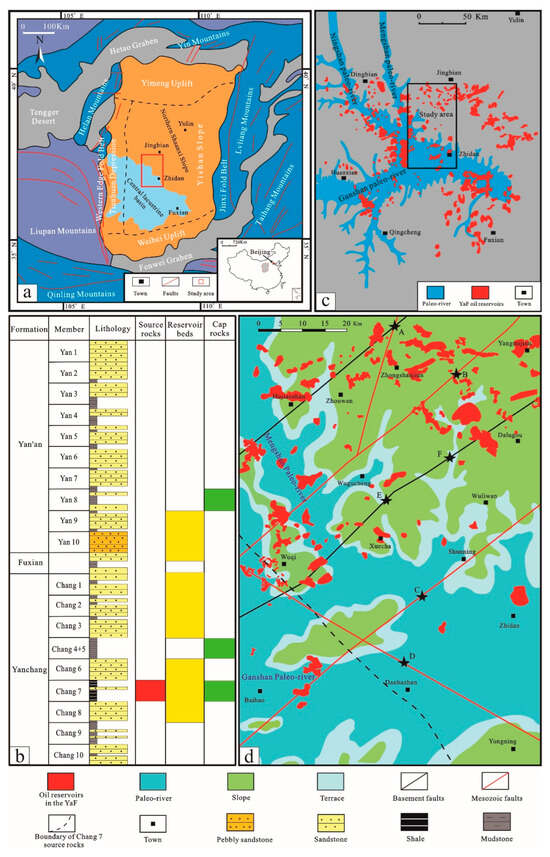
Figure 1.
Tectonic map of the Ordos Basin (a), Mesozoic petroleum system in the basin (b) [26,28,29], distribution of the pre-Jurassic paleo-rivers and Yan’an Formation oil reservoirs (c), and pre-Jurassic paleogeomorphology and faults in the Zhijing area (d).
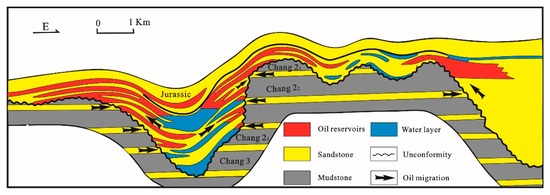
Figure 2.
The reported oil migration model in the Jurassic Yan’an Formation [26].
This study takes the Mesozoic petroleum system in the Zhijing area of the central Ordos Basin as a case study and adopts an approach combining petrography, biomarkers, and nitrogen compound analysis. The aim is to identify the oil vertical migration through tectonic fractures. It reveals that the distribution of the YaF oils is controlled by tectonic fractures rather than paleo-rivers, refines the previous accumulation model for the YaF oils, and provides a reference for identifying oil migration through tectonic fractures in stable cratons.
2. Geological Background
2.1. Tectonic–Sedimentary Evolution
Increased extrusion from the Qinling orogenic belt caused accelerated subsidence in the southern Ordos Basin during the Late Middle Triassic, which induced the YcF deposition throughout the entire basin [30,31,32,33]. The YcF was deposited in a lacustrine delta environment [34,35], which generated the high-quality Chang 7 source rocks in the deep lake area. During the Late Triassic, the Indosinian Orogeny resulted in the overall uplift of the basin, which was accompanied by the erosion of the YcF and the formation of gully landforms. Several great paleo-rivers were developed within the basin, in which the Fuxian Formation was deposited. Two great paleo-rivers (i.e., the Mengshan paleo-river and Ganshan paleo-river) converged in the study area (Figure 1d). During the Middle Jurassic, the basin entered another lacustrine basin development stage and yielded the YaF deposition. Both the YcF and YaF are subdivided into ten members from top to bottom (Figure 1b).
2.2. Source–Reservoir–Cap Condition
The dark shale and mudstone in the Chang 7 member are reported to be the primary oil source in the Mesozoic petroleum system in the basin [36,37,38]. Furthermore, the Chang 9 and Chang 8 members also contain source rocks in several limited areas, including the Zhijing area [26,39]. The source rocks have undergone at least two episodes of oil expulsion, and the main oil expelling period is the Late Early Cretaceous when the source rocks reached the maximum burial depth [40].
The reservoirs in the study area mainly consist of tight sandstones within the Chang 7 and Chang 6 members, as well as the Yan 10 and Yan 9 sandstones with medium-low porosity and permeability. The YcF tight sandstones are believed to have been formed prior to the main oil expelling period [41].
Cap rocks are represented by the Chang 4 + 5, Chang 7, and Yan 8 members, in which mudstones are developed (Figure 1b).
2.3. Faults
The Ordos Basin used to be regarded as a stable craton basin surrounded by several deep faults, but now it is believed to contain a series of faults and tectonic fractures within its interior [42,43]. According to the 3D seismic survey, four Mesozoic faults and two basement faults have been identified in the Zhijing area [27,44] (Figure 1d). All these faults are nearly upright and cut across the YcF and YaF with few fault throws (Figure 3). The faults across the northern area are characterized by NE-SW trending (Figure 1d) and long longitudinal extension from the YcF bottom to the Cretaceous (e.g., Figure 3A,B,E,F). On the contrary, the faults in the southern area did not cut across the YcF bottom (e.g., Figure 3C,D). These faults were generated by the Yanshan Orogeny during the Jurassic and Cretaceous, subsequently altered by the Himalayan Orogeny during the Neogene [45].
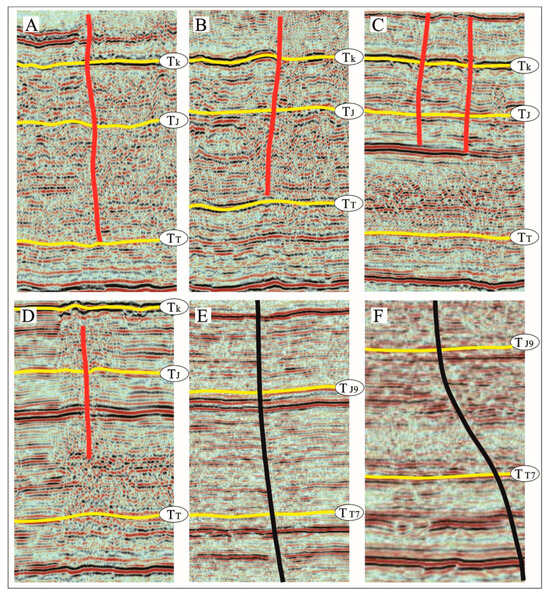
Figure 3.
Interpreted faults in the seismic sections in the Zhijing area, Ordos Basin: (A–F) correspond to (A–F) in Figure 1d, respectively; TK—Cretaceous bottom; TJ—Jurassic bottom; TT—Triassic bottom; TT7—Chang 7 Member bottom; TJ9—Yan 9 Member bottom [27,44].
3. Samples and Methods
Core samples from 28 wells in the Zhijing area, representing the Yanchang Formation (YcF) and Yan’an Formation (YaF), were analyzed in this study. The fracture properties present in the cores including types, occurrence, length, linear density and fracture fillings have been carefully recorded.
Thirty crude oil samples were collected from the Yan 10, Yan 9, Chang 6, and Chang 4 + 5 members in the area. Gas chromatography was conducted on the crude oils using the Trace 1300 system equipped with an HP-1 capillary column (60 m × 0.25 mm × 0.25 mm) following the procedures described by Yang et al. (2023) [46].
The oil samples were separated into saturated, aromatic, non-hydrocarbon, and asphaltene fractions by silica gel and alumina column chromatography. Gas chromatography–mass spectrometry (GC–MS) was performed on crude oil samples using the Trace 1300-ISQ QD300 system (manufactured by THERMO, Waltham, MA, USA) equipped with an HP-5MS capillary column (60 m × 0.25 mm × 0.25 mm). Pyrrolic nitrogen compounds were isolated from nineteen non-hydrocarbon fractions by column chromatography with silicic acid and elution with n-hexane/toluene (1:1, volume/volume). The GC–MS analyses of the nitrogen compounds were performed using a Bruker Scion TQ system (manufactured by Bruker Corporation, Billerica, MA, USA) equipped with an HP-5MS fused silica capillary column (30 m × 0.25 mm × 0.25mm). The instrument parameters for the GC–MS analyses of the saturated fractions and nitrogen compounds were set following Wang et al. (2019) [47].
4. Results
4.1. Fracture Characteristics
Fractures within the cores can be classified into tectonic fractures and non-tectonic fractures according to their geological genesis [48], which accounts for 26% and 74% of the total quantity, respectively. The tectonic fractures cut across different lithological layers with apparent lengths varying from 5 cm to 50 cm (Figure 4). Seventy-seven percent of the YcF core samples contain tectonic fractures, with densities ranging from 0.4 to 1.4 fractures per meter, while thirty-one percent of the YaF cores contain tectonic fractures with apparent densities ranging from 0.18 to 1.26 fractures per meter. According to the core observation, 78% of tectonic fractures are partially filled, while 19% of those are unfilled (e.g., Figure 4a,b). Only 3% of the tectonic fractures are completely filled. The filling matter in the tectonic fractures consists of predominant calcite cements (e.g., Figure 4d,e). Only 2% of the tectonic fractures contain solid bitumen (e.g., Figure 4c).
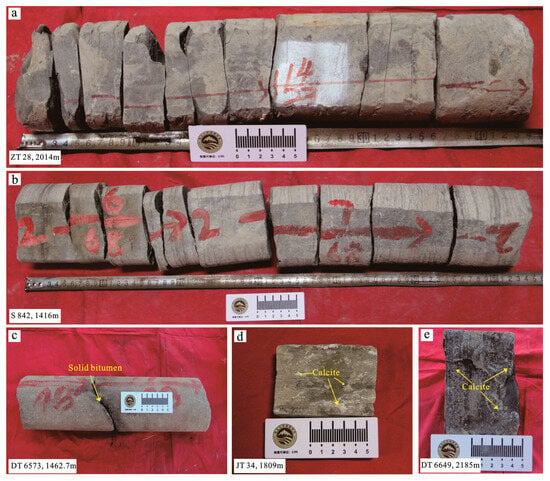
Figure 4.
Tectonic fractures in the cores in the Zhijing area, central Ordos Basin (a); (b) tectonic fractures are unfilled; (c) tectonic fractures are filled with solid bitumen; (d,e) tectonic fractures are filled with calcite cement.
The non-tectonic fractures are dominated by bedding-parallel fractures, which exhibit a larger quantity and smaller scale than tectonic fractures. Bedding-parallel fractures are prominent within the YcF, especially in the Chang 7 and Chang 6 members. However, they are not developed in the YaF.
4.2. N-Alkane and Isoprenoid Alkanes
The Carbon Preference Index (CPI) serves as the parameter used to characterize the thermal maturity of crude oils [49]. The CPI values of the YcF and YaF oils range from 1.08 to 1.10 and from 1.09 to 1.16, respectively (Table 1). None of the oils showed odd–even carbon number predominance, indicating that they are mature oils [50].

Table 1.
Biomarker parameters for the crude oils in the Zhijing area, central Ordos Basin.
The abundance of n-alkane in unaltered mature oils exponentially decreases as the carbon number increases [51]. However, secondary alterations such as gas invasion, gas washing, evaporative fractionation, and biodegradation can significantly break this pattern [23,29,43,52]. The n-alkanes with a carbon number less than 18 (nC18–) in the YaF oils appear disorderly, with obvious “mismatches” at n-undecane (e.g., Figure 5a–f). In contrast, the YcF oils are very similar to normal mature oils (e.g., Figure 5g–i), except for slight light-end depletion in several oils (e.g., Figure 5i).

Figure 5.
n-Alkane distribution patterns of representative oils from the Zhijing area, Ordos Basin. (a–f) n-alkane distribution patterns of YaF oils, (g–i) n-alkane distribution patterns of YcF oils.
Pristane (Pr) and Phytane (Ph) are commonly used to reflect the redox properties of a depositional environment [53]. The Pr/Ph values of the YaF oils range from 1.20 to 1.41, while those of the YcF oils vary from 1.13 to 1.32 (Table 1), exhibiting high similarity between the YaF and YcF oils. The Pr/nC17 and Ph/nC18 values for the YaF and YcF oils are also similar, ranging from 0.3 to 0.9 and from 0.25 to 0.69, respectively (Table 1). These Pr/nC17 and Ph/nC18 values are very normal, indicating the absence of biodegradation in the oils [37,54].
4.3. Terpanes
Tricyclic Terpanes (TTs) have been widely applied to oil–source correlation due to their high thermal stability and resistance to biodegradation [55]. The C21/C20TT and C23/C21TT values from the oils are very close and are all greater than 1 (Table 1), exhibiting the same abundance distribution pattern of C20 < C21 < C23TT.
C30M/H (C30Moretane/C30Hopane), C29Ts/N (C29-Normeohopane/C29Norhopane), and Ts/Tm are often used to evaluate the maturity of organic matter [56,57,58]. The C30M/H values of oil samples range from 0.08 to 0.14, indicating that the YaF and YcF oils are both predominantly mature. The Ts/Tm and C29Ts/N values of the YaF oils range from 0.62 to 1.22 and from 0.21 to 0.37, respectively (Table 1), while those of the YcF oils vary from 0.38 to 1.93 and from 0.16 to 0.51, respectively (Table 1).
The C30* (C30Diahopanes/C30Hopane) possesses dual geochemical attributes indicative of maturity and biological origin [59]. The C30* values for the YaF and YcF oils range from 0.02 to 0.14 and from 0.02 to 0.09, respectively.
4.4. Steranes
C29 Steranes and C27 Steranes originate from terrestrial plants and plankton, respectively [60]. Thus, αααRC27/C29 Sterane (ααα-20RC27Sterane /ααα-20RC29Sterane) is always used as an indicator for identifying the biological origin of oils. In the study area, the αααRC27/C29 Sterane ratios of the YcF and YaF oils are similar, which range from 0.80 to 1.24 and from 0.89 to 1.44, respectively (Table 1).
4.5. Pyrrolic Nitrogen Compounds
The concentrations of the nitrogen compounds and their ratios for the crude oils in the study area are illustrated in Table 2.

Table 2.
Nitrogen compound parameters for the oils in the Zhijing area, central Ordos Basin.
5. Discussion
5.1. Oil Source
Although the Mesozoic oils in the basin have been reported to primarily originate from the widely distributed Chang 7 source rocks [38], it is necessary to determine the oil source for the studied oils, because the locally distributed Chang 8 and Chang 9 source rocks are also developed in the study area [37]. According to the oil–source correlation (Figure 6), the YaF and YcF oils in the area are still evidenced to be originated from the Chang 7 rather than the Chang 8 and Chang 9 source rocks. Notably, the Chang 7 shale/mudstone exhibits a wide spatial distribution, covering the central lacustrine basin and northern Shaanxi Slope (Figure 1a) [43,61,62,63,64]. In order to accurately ascertain the oil source, this study analyzed the Chang 7 biomarker differences between the central lacustrine basin and northern Shaanxi Slope.
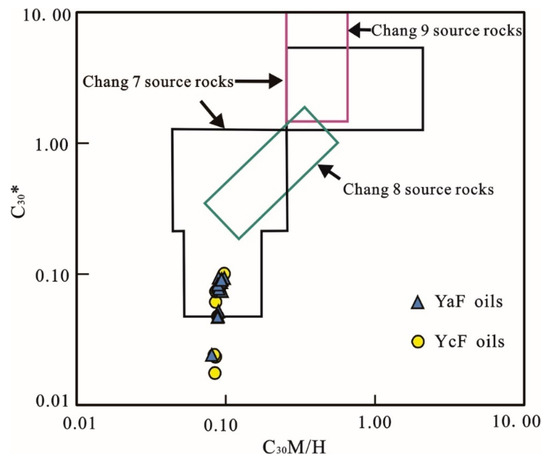
Figure 6.
Oil–source correlation for the studied oils in the Zhijing area, Ordos Basin [36,37].
Compared with the central lacustrine basin, the biomarkers in the Chang 7 shale/mudstone from the northern Shaanxi Slope are characterized by greater Pr/Ph values and lower αααRC27/C29 Sterane values (Figure 7a), indicating that these shale/mudstones were deposited in a relatively more oxidized environment with more terrestrial input. Based on the detailed oil–source correlation (Figure 7b), the YaF and YcF oils in the Zhijing area are both from the Chang 7 source rocks in the central lacustrine basin. This is further evidenced by the C20-C21-C23TT distribution patterns. The C20-C21-C23TTs in the Chang 7 shale/mudstone in the northern Shaanxi Slope exhibit a C20 < C21 > C23TT pattern, while those in the central lacustrine basin exhibit a C20 < C21 < C23TT pattern [64]. As shown in Table 1, the C20-C21-C23TTs of oils in the area all show a C20 < C21 < C23TT pattern, which is the same as that in the central lacustrine basin.

Figure 7.
Spatial differences of the Chang 7 biomarkers [38,61,62,63,65] (a), and detail oil-source correlation for the studied oils in the Zhijing area, Ordos Basin (Overlay of studied oils on the Chang 7 biomarker background in Figure 7a) (b).
According to the distribution range of the Chang 7 source rocks defined by Wang et al. (2023) [64], this study determines the boundary of the oil source for the oils in the Zhijing area. As shown in Figure 1d, the oil source only occupies the southwestern area.
5.2. Identification of Oil Vertical Migration Through Faults or Tectonic Fractures
The YaF oil reservoirs in the study area are mainly distributed in the areas to the northeast of the oil source (Figure 1d). The horizontal distances from the oil reservoirs to the boundary of the oil source can be as far as 80 km. This indicates that the YaF oils must have undergone both vertical and lateral migration after being expelled from the Chang 7 oil source. It is well known that the connected sand bodies in the YcF and YaF are good carrier beds for oil lateral migration [26]. The pathways for oil vertical migration have been reported to be superimposed sand bodies and pre-Jurassic paleo-river channels [21,25,26]. Faults or tectonic fractures, however, were rarely reported to be the pathways of oil vertical migration. The reason may be attributed to the absence of evidence for oil vertical migration through tectonic fractures. In this study, for example, only 2% of tectonic fractures were observed to contain a little solid bitumen. The low proportion challenges the hypothesis of vertical oil migration through tectonic fractures. Thus, traditional petrographic observation method is limited in tracing oil vertical migration through tectonic fractures in the study area.
However, our work identifies this migration process based on a series of geochemical and geological analysis with the following evidence.
5.2.1. Evidence from the Light Fraction of Crude Oils
The Ts/Tm and C29Ts/N values of the YaF oils are very close to those of the YcF oils (Figure 8), suggesting that these oils are at the same maturity level. Considering that all the oils in the area are from the same oil source, the YaF and YcF oils are expected to have similar hydrocarbon compositions. However, obvious differences exist in the n-alkane distribution between the YaF and YcF oils (Figure 5). These differences are not related to oil source and thermal maturity but are most likely associated with the oil migration process. It is well known that the YcF oils primarily underwent lateral migration along sand bodies. They exhibit a relative regular n-alkane distribution (e.g., Figure 5g,h). In contrast, the n-alkane distributions of the YaF oils are not regular, showing disorder nC18-distribution and “mismatches” at n-undecane (e.g., Figure 5a–f).
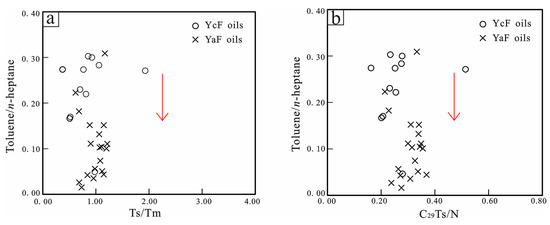
Figure 8.
Cross-plots of toluene/n-heptane versus Ts/Tm (a) and toluene/n-heptane versus C29Ts/N (b) for the studied oils in the Zhijing area, central Ordos Basin.
Oil migration, particularly the vertical migration through faults or fractures, is always accompanied by the rapid evolution of temperature and pressure. A significant decrease in temperature and pressure conditions is prone to induce phase fractionation, which is characterized by the separation of the light fraction and heavy fraction of oils [23,29,43]. The disorder nC18-distribution and the “mismatches” at n-undecane in the YaF oils (e.g., Figure 5a–f) should be the characteristic of phase fractionation [66,67,68,69], which results from the separation and re-mixing of light and heavy fractions of the migrating oils. Thus, the YaF oils should have undergone a vertical migration process through faults or fractures.
In addition, toluene/n-heptane is also an indicator for identifying phase fractionation. Phase fractionation can result in a decrease in toluene/n-heptane ratios in the light fractions compared to the original unaltered oils [70]. As shown in Figure 8, the toluene/n-heptane ratios of the YaF oils are obviously lower than those of the YcF oils, indicating that more light fractions from the original oils have migrated to the YaF due to the phase fractionation occurring in the oil vertical migration through faults or fractures.
5.2.2. Evidence from the Maturity of Crude Oils
For the same-sourced oils, their maturities usually decrease with increasing migration distance [47,71]. This is often used to trace the pathways of oil migration [47]. Given that the studied oils are all from the same oil source, the maturity parameter Ts/Tm was used to trace petroleum migration in the study area.
As shown in Figure 9a, the Ts/Tm values of the Chang 6 oils gradually decrease northeastward from 1.93 to 0.51 along NE trending sand bodies, indicating a lateral migration in a northeastward direction. This variation trend of the Ts/Tm values, however, did not occur in the YaF. As shown in Figure 9b, the Ts/Tm values of the YaF oils adjacent to the Mengshan paleo-river are significantly lower than those in the Zhongshanjian–Yangmijian area far from the paleo-river.
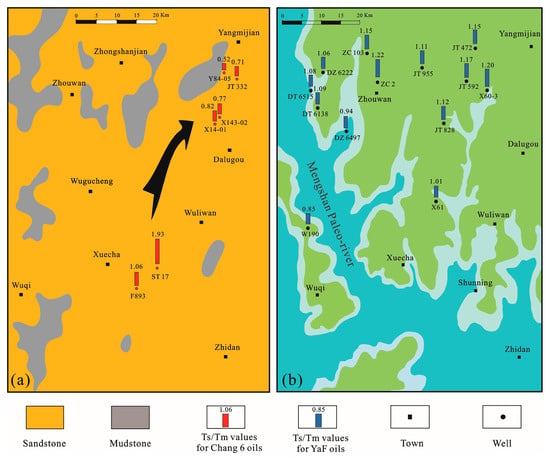
Figure 9.
Spatial distribution of Ts/Tm values for oils in Change 6 (a) and the Yan’an Formation (b) in the Zhijing area, Ordos Basin.
Furthermore, the Ts/Tm values of the YaF oils are disordered in spatial distribution without clear variation trends (Figure 9b). This maturity distribution pattern does not support a long-distance lateral migration for the oils from the paleo-rivers. However, this phenomenon is best explained by vertical oil migration through faults or tectonic fractures: the YcF oils vertically migrate and inject into the YaF at multiple points. The high Ts/Tm values in several wells are expected to be the geochemical response to the injection points of the underlying YcF oils.
5.2.3. Evidence from the Nitrogen Compounds in Crude Oils
Pyrrolic nitrogen compounds are crucial indicators for tracing oil migration. With the increasing migration distance, the ratios of shielded to exposed isomers gradually increase [72,73]. Accordingly, the nitrogen compound parameters 1/4-MC and 1,8/2,7-DMC are used to trace the migration pathways of the YaF oils in the area.
As shown in Figure 10, the values of 1/4-MC and 1,8/2,7-DMC are disordered in spatial distribution without clear variation trends, which is very similar to the spatial distribution pattern of the Ts/Tm values. The disordered spatial distribution of the nitrogen compounds does not support the long-distance lateral migration of the YaF oils either. But this can be well explained by the oil vertical migration through faults or tectonic fractures. Notably, the high values of 1/4-MC and 1,8/2,7-DMC exactly correspond to the high Ts/Tm values (Figure 9b), which may be due to the geochemical response to the injection points of the underlying YcF oils.
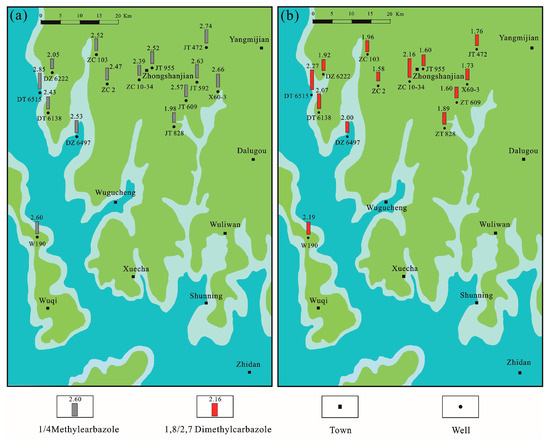
Figure 10.
Spatial distribution of 1/4-MC values (a) and 1,8/2,7-DMC values (b) for the Yan’an Formation oils in the Zhijing area, Ordos Basin.
5.2.4. Evidence from the Spatial Distribution of Oil Reservoirs
The spatial distribution correlation of the YaF and YcF oil reservoirs provides more evidence for the oil vertical migration through faults or fractures. As illustrated in Figure 11, the areas that are occupied by the YaF oil reservoirs exhibit an absence of the YcF oil reservoirs (e.g., Zhongshanjian area), and vice versa. This spatial complementarity provides important oil migration information.
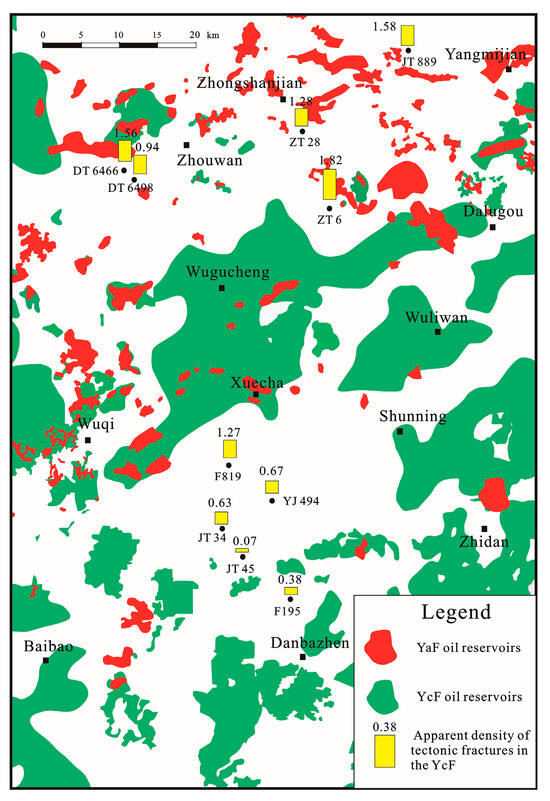
Figure 11.
Distribution of oil reservoirs and apparent density of tectonic fractures within the Yanchang Formation in the Zhijing area, Ordos Basin.
The Chang 6, Yan 10, and Yan 9 members are the main reservoirs in the Mesozoic petroleum system in the basin. In the Zhijing area, these members are characterized by widespread sandstones throughout the entire studied area. As stated above, the Chang 6 oils mainly migrated laterally along sand bodies from the southwestern oil source to the northeastern reservoirs. If the YaF oils have also undergone a long-distance lateral migration from the southwestern paleo-rivers to the northeastern reservoirs, it is very likely to cause large-scale spatial overlap of the YaF and YcF oil reservoirs rather than the spatial complementarity of the YaF and YcF oil reservoirs.
However, this spatial complementarity can be well explained by oil vertical migration from the YcF to YaF following this scenario: (1) the YcF oils migrated northeastward along the connected sand bodies; (2) in the areas with few faults or tectonic fractures, the oils accumulated in the traps during the lateral migration; (3) in the areas with developed faults or tectonic fractures, the migrating oils or the oils leaving original oil reservoirs due to tectonic activities migrated vertically through the faults or tectonic fractures into the YaF; (4) the injected oils accumulated in the YaF traps adjacent to the faults or tectonic fractures.
5.3. Pathways for Oil Vertical Migration
As stated above, all the evidence from the light fraction, maturity, nitrogen compounds, and spatial distribution indicates a vertical migration through faults or tectonic fractures. In order to verify the vertical migration pathways, we observed the spatial relationship between the YaF oil reservoirs and faults and found a good spatial correspondence between them. The YaF oil reservoirs in the area are mainly distributed in the NE-SW trending fault zone across the northern area (Figure 1d), in which the faults are characterized by longer longitudinal extension (e.g., Figure 3A,B,E,F) and greater apparent density of tectonic fracture than those in the southern area (Figure 11). Thus, the faults and their associated tectonic fractures indeed have served as the pathways for the oil vertical migration in the study area.
Considering that (1) all the faults in the area are nearly upright with few fault throws (Figure 3), (2) 77% of the YcF cores contain tectonic fractures, but no faults were observed in this study, and (3) the maturity and nitrogen compound parameters of the YaF oils did not exhibit clear variation trends from the fault to the distant oil reservoirs (Figure 9b and Figure 10), tectonic fractures are expected to be the main pathways for the oil vertical migration in the area.
5.4. Oil Migration Process Within the Mesozoic Petroleum System
A conceptual model for the oil migration in the Mesozoic petroleum system in the Zhijing area is established (Figure 12) based on (1) the above identified vertical migration process through tectonic fractures and (2) the charging history and migration process reported by previous studies [23,26,40].
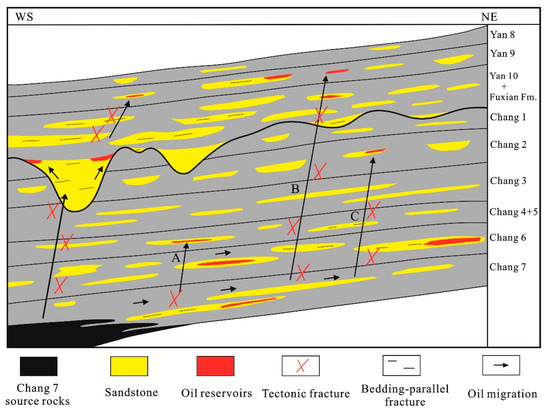
Figure 12.
Oil migration model in the Mesozoic petroleum system in the Zhijing area.
During the Late Jurassic and late period of the Early Cretaceous, two episodes of oils were expelled out from the Chang 7 source rocks in the central lacustrine basin, respectively. The oils firstly injected into the adjacent Chang 7 or Chang 6 sandstones and laterally migrated northeastward along the connected sand bodies. During the lateral migration, a part of the oils accumulated in the traps on the migration pathways, while the other part continued to migrate. Once the migrating oils encountered opened tectonic fractures or the oil reservoirs in the YcF were destroyed by the later-formed tectonic fractures, oil vertical migration occurred.
The vertical migration distance of oils is probably controlled by the vertical connectivity of tectonic fractures. In the areas with low vertical connectivity, the oils migrated from the Chang 7 member to the Chang 6 member and even the Chang 4 + 5 member through the tectonic fractures across these members (e.g., migration process A in Figure 11) or superimposed sand bodies. In the areas with high vertical connectivity, the oils could migrate directly from the Chang 7 or Chang 6 members to the YaF through tectonic fractures (e.g., migration processes B and C in Figure 12).
The new insights into the oil migration process within the Mesozoic petroleum system refine the previous accumulation model for the YaF oils (i.e., oil accumulation controlled by the paleo-river channels). This study suggests that the oil accumulation in the YaF, in fact, is controlled by the injection positions of the vertical migrating oils through developed tectonic fractures. If the injection positions occur in the paleo-river channels, the YaF oil reservoirs accumulated here are indeed controlled by the paleo-river channel, which is consistent with the previous view. However, if the injection positions occur in the areas far from paleo-river channels, the YaF oil accumulation there cannot be related to paleo-river channels but is related to the structural–lithological traps adjacent to the injection positions.
6. Conclusions
The Zhijing area in the central Ordos Basin (Central China) was used as a case to demonstrate that the combined use of geochemical and geological records is a robust tool to identify oil vertical migration through tectonic fractures. Furthermore, the case study in the Zhijing area provides new insights into the oil migration process within the Mesozoic petroleum system in the Ordos Basin. Important findings of this study include the following:
- (1)
- Lots of tectonic fractures, but no faults, were observed in the YcF and YaF cores. A total of 77% of the YcF cores contain tectonic fractures, while 31% of the YaF cores contain them. The NE-SW trending fault zone across the northern Zhijing area is characterized by longer longitudinal extension and a greater apparent density of tectonic fracture than the zones in the southern area. A total of 81% of the tectonic fractures are filled by predominant calcite cements, but only 2% of the tectonic fractures contain solid bitumen.
- (2)
- The studied oils are all originated from the same oil source, and the maturities of the YaF and YcF oils are similar. However, compared with the YcF oils, the YaF oils show disordered nC18-distribution and “mismatches” at n-undecane, as well as decrease in toluene/n-heptane ratios. These differences are not related to the oil source and thermal maturity but are associated with the oil migration process. The rapid vertical migration through faults or tectonic fractures is expected to cause the separation and re-mixing of light and heavy fractions of the migrating oils.
- (3)
- The 1/4-MC, 1,8/2,7-DMC, and Ts/Tm values of the YaF oils are all disordered in spatial distribution without clear variation trends. These distribution patterns do not support a long-distance lateral migration for the oils from the paleo-rivers but can be well explained by the oil vertical migration through faults or tectonic fractures.
- (4)
- Areas occupied by YaF oil reservoirs lack YcF oil reservoirs, and vice versa. This spatial complementarity resulted from vertical oil migration from the YcF to YaF.
- (5)
- Once the migrating oils in the YcF encounter opened tectonic fractures or the YcF oil reservoirs are destroyed by the later-formed tectonic fractures, oil vertical migration from the YcF to YaF would occur. This study offers new insights into the oil migration processes within the Mesozoic petroleum system of the Ordos Basin and refines the previous accumulation model for the YaF oils.
- (6)
- The method, which comprehensively analyzes the characteristics of the light fractions, maturity, nitrogen compounds of crude oils, and the spatial distribution of oil reservoirs, provides effective evidence for demonstrating oil vertical migration through tectonic fractures. It can clarify the oil migration pathways and is of great significance for oil exploration.
Author Contributions
Conceptualization, Y.R.; methodology, Y.R.; validation, A.W.; investigation, Y.R.; resources, Y.D., B.W., C.L. and Z.L.; writing—original draft preparation, Y.R.; writing—review and editing, A.W.; visualization, J.W. (Jie Wang) and J.W. (Jinxiang Wei); supervision, A.W.; project administration, A.W.; funding acquisition, A.W. All authors have read and agreed to the published version of the manuscript.
Funding
This research was funded by the Natural Science Foundation of Shaanxi Province (Grant number 2020JQ-59, 2022JQ-290).
Data Availability Statement
The original contributions presented in this study are included in the article. Further inquiries can be directed to the corresponding author.
Acknowledgments
We thank Dan Wu for her valuable advice on the sentence structure and expression of this manuscript.
Conflicts of Interest
Authors Yanjun Du and Bianyang Wang were employed by the company Shaanxi Yanchang Petroleum (Group) Co., Ltd., Chunyu Li was employed by the company Heilongjiang Transportation Investment Group Co., Ltd. The remaining authors declare that the research was conducted in the absence of any commercial or financial relationships that could be construed as a potential conflict of interest.
References
- Odling, N.E.; Webman, I. A “conductance” mesh approach to the permeability of natural and simulated fracture patterns. Water Resour. Res. 1991, 27, 2633–2643. [Google Scholar] [CrossRef]
- Hennings, P.; Allwardt, P.; Paul, P.; Zahm, C.; Reid, R.; Alley, H.; Kirschner, R.; Lee, B.; Hough, E. Relationship between fractures, fault zones, stress, and reservoir productivity in the Suban gas field, Sumatra, Indonesia. AAPG Bull. 2012, 96, 753–772. [Google Scholar] [CrossRef]
- Zeng, L.; Tang, X.; Wang, T.; Gong, L. The influence of fracture cements in tight Paleogene saline lacustrine carbonate reservoirs, western Qaidam Basin, northwest China. AAPG Bull. 2012, 96, 2003–2017. [Google Scholar] [CrossRef]
- Ju, W.; Wu, C.; Wang, K.; Sun, W.; Li, C.; Chang, X. Prediction of tectonic fractures in low permeability sandstone reservoirs: A case study of the Es3m reservoir in the Block Shishen 100 and adjacent regions, Dongying depression. J. Pet. Sci. Eng. 2017, 156, 884–895. [Google Scholar] [CrossRef]
- Zhang, X.; Shi, W.; Hu, Q.; Zhai, G.; Wang, R.; Xu, X.; Meng, F.; Liu, Y.; Bai, L. Developmental characteristics and controlling factors of natural fractures in the lower paleozoic marine shales of the upper Yangtze Platform, southern China. J. Nat. Gas Sci. Eng. 2020, 76, 103191. [Google Scholar] [CrossRef]
- Liu, G.; Zeng, L.; Zhu, R.; Gong, L.; Ostadhassan, M.; Mao, Z. Effective fractures and their contribution to the reservoirs in deep tight sandstones in the Kuqa Depression, Tarim Basin, China. Mar. Pet. Geol. 2021, 124, 104824. [Google Scholar] [CrossRef]
- Laubach, S.E.; Ward, M.E. Diagenesis in porosity evolution of opening-mode fractures, Middle Triassic to Lower Jurassic La Boca Formation, NE Mexico. Tectonophysics 2006, 419, 75–97. [Google Scholar] [CrossRef]
- Yao, J.; Zhao, Y.; Liu, G.; Qi, Y.; Li, Y.; Luo, A.; Zhang, X. Formation patterns of Chang 9 oil reservoir in Triassic Yanchang Formation, Ordos Basin, NW China. Pet. Explor. Dev. 2018, 45, 389–401. [Google Scholar] [CrossRef]
- Laubach, S.; Marrett, R.; Olson, J. New directions in fracture characterization. Geophysics 2000, 19, 673–816. [Google Scholar] [CrossRef]
- Pudji, P.; Taufan, M.; Sesila, N.; Kharisma, I. Identification and characterization of microfractures in carbonate samples. Pet. Explor. Dev. 2022, 49, 366–376. [Google Scholar]
- Peacock, D.; Mann, A. Evaluation of the controls on fracturing in reservoir rocks. J. Pet. Geol. 2006, 28, 385–396. [Google Scholar] [CrossRef]
- Zeng, L.; Song, Y.; Liu, G.; Tan, X.; Xu, X.; Yao, Y.; Mao, Z. Natural fractures in ultra-deep reservoirs of China: A review. J. Struct. Geol. 2023, 175, 104954. [Google Scholar] [CrossRef]
- Marrett, R.; Laubach, S.E.; Kim, K. Diagenetic controls on fracture permeability and sealing. Int. J. Rock Mech. Min. Sci. Geomech. Abstr. 1997, 34, 204–409. [Google Scholar] [CrossRef]
- Luczaj, J.A.; Harrison, W.B.I.; Smith Williams, N. Fractured hydrothermal dolomite reservoirs in the Devonian Dundee formation of the central Michigan Basin. AAPG Bull. 2006, 90, 1787–1801. [Google Scholar] [CrossRef]
- Prioul, R.; Jocker, J. Fracture characterization at multiple scales using borehole images, sonic logs, and walkaround vertical seismic profile. AAPG Bull. 2009, 93, 1503–1516. [Google Scholar] [CrossRef]
- Zeng, L.; Lyu, W.; Li, J.; Zhu, L.; Weng, J.; Yue, F.; Zu, K. Natural fractures and their influence on shale gas enrichment in Sichuan Basin, China. J. Nat. Gas Sci. Eng. 2016, 30, 1–9. [Google Scholar] [CrossRef]
- Lin, F.; Bodnar, R.J.; Becker, S.P. Experimental determination of the Raman CH4 symmetric stretching (ν1) band position from 1–650bar and 0.3–22 °C: Application to fluid inclusion studies. Geochim. Cosmochim. Acta 2007, 71, 3746–3756. [Google Scholar] [CrossRef]
- Lu, W.; Chou, I.; Burruss, R.C.; Song, Y. A unified equation for calculating methane vapor pressures in the CH4–H2O system with measured Raman shifts. Geochim. Cosmochim. Acta 2007, 71, 3969–3978. [Google Scholar] [CrossRef]
- Chen, Z.; Yang, Y.; Wang, T.G.; Cheng, B.; Li, M.; Luo, B.; Chen, Y.; Ni, Z.; Yang, C.; Chen, T.; et al. Dibenzothiophenes in solid bitumens: Use of molecular markers to trace paleo-oil filling orientations in the Lower Cambrian reservoir of the Moxi–Gaoshiti Bulge, Sichuan Basin, southern China. Org. Geochem. 2017, 108, 94–112. [Google Scholar] [CrossRef]
- Yuan, Z. Research on Sedimentary Facies of Jurassic Yan’an Formation and Disciplinarian of Accumulation Oil & Gas in Ansai oilfield of Ordos Basin. Master’s Thesis, Northwest University, Xi’an, China, 2007. [Google Scholar]
- Dai, T.Y. Relation Between Pre-Jurassic Paleogeomorphology and Hydrocarbon Accumulation in Zhenyuan Area. Master’s Thesis, Chengdu University of Technology, Chengdu, China, 2016. [Google Scholar]
- Fu, J.H.; Dong, G.D.; Zhou, X.P.; Hui, X.; Dan, W.D.; Fan, L.Y.; Wang, Y.G.; Zhang, H.T.; Gu, Y.H.; Zhou, G.X. Research progress of petroleum geology and exploration technology in Ordos Basin. China Pet. Explor. 2021, 26, 19–40. [Google Scholar]
- Zhang, C.L.; Liu, X.S.; Yang, Y.J.; Yu, J.; Han, T.Y.; Zhang, Y. Petroleum exploration history and enlightenment of Changqing oilfield in Ordos Basin. Xinjiang Pet. Geol. 2021, 42, 253–263. [Google Scholar]
- Pu, L.; Liu, Y.N.; Liu, W.; Zhou, S.X.; Xin, H.G.; Li, J.H. Pre-Jurassic paleogeomorphology characteristics and its reservoir control in northern Shaanxi Area of Ordos Basin. J. Yangtze Univ. (Nat. Sci. Ed.) 2022, 19, 22–31. [Google Scholar]
- Zhao, D.L.; Bai, Y.B.; Zhang, H. Characteristics and accumulation mechanisms of Yan 9 reservoir in Jingbian oilfield, Ordos Basin. Xinjiang Geol. 2022, 40, 388–393. [Google Scholar]
- Qu, H.; Yang, B.; Gao, S.; Zhao, J.; Han, X.; Chen, S.; Hayat, K. Controls on hydrocarbon accumulation by facies and fluid potential in large-scale lacustrine petroliferous basins in compressional settings: A case study of the Mesozoic Ordos Basin, China. Mar. Pet. Geol. 2020, 122, 104668. [Google Scholar] [CrossRef]
- Wang, Q. Reservoir Characteristics and Main Controlling Factors of Jurassic Yan’an Formation in Wuqi-Ansai Area. Master’s Thesis, Chang’an University, Xi’an, China, 2021. [Google Scholar]
- Liang, J.W. Research on Sedimentary System and Squence Stratigraphy of the Jurassic in Ordos Basin. Ph.D. Thesis, Northwest University, Xi’an, China, 2007. [Google Scholar]
- Su, F.Y.; Zhou, W.; Jin, W.H.; Deng, H.C.; Liu, Y. Identification and distribution of the Mesozoic plays in Ordos Basin. Oil Gas Geol. 2012, 33, 582–590. [Google Scholar]
- Liu, C.Y.; Zhao, H.G.; Gui, X.J.; Yue, P.L.; Zhao, J.F.; Wang, J.Q. Space-time coordinate of the evolution and reformation and mineralization response in Ordos Basin. Acta Geol. Sin. 2006, 80, 617–638. [Google Scholar]
- Ji, L.; Yan, K.; Meng, F.; Zhao, M. The oleaginous botryococcus from the Triassic Yanchang formation in Ordos Basin, northwestern China: Morphology and its paleoenvironmental significance. J. Asian Earth Sci. 2010, 38, 175–185. [Google Scholar] [CrossRef]
- Zou, C.; Zhang, X.; Luo, P.; Wang, L.; Luo, Z.; Liu, L. Shallow-lacustrine sand-rich deltaic depositional cycles and sequence stratigraphy of the Upper Triassic Yanchang Formation, Ordos Basin, China. Basin Res. 2010, 22, 108–125. [Google Scholar]
- Yang, H.; Deng, X. Deposition of Yanchang Formation deep-water sandstone under the control of tectonic events in the Ordos Basin. Pet. Explor. Dev. 2013, 40, 549–557. [Google Scholar] [CrossRef]
- Li, W.H.; Liu, X.; Zhang, Q.; Guo, Y.; Li, K.Y.; Yuan, Z.; Wang, Y.; Ma, Y.; Bai, J.L.; Yang, B.; et al. Deposition evolution of Middle-Late Triassic Yanchang formation in Ordos Basin. J. Northwest Univ. (Nat. Sci. Ed.) 2019, 49, 605–621. [Google Scholar]
- Zhai, M.G. Ordos Block (Basin) is a key to understand early continental evolution and tectonic regime of the North China Craton. Chin. Sci. Bull. 2021, 66, 3441–3461. [Google Scholar] [CrossRef]
- Zhang, W.Z.; Yang, H.; Hou, L.H.; Liu, F. Distribution and geological significance of 17α(H)-diahopanes from different hydrocarbon source rocks of Yanchang Formation in Ordos Basin. Geochimica 2009, 39, 1438–1445. [Google Scholar] [CrossRef]
- Zhou, S.Y. Evaluation of the Chang 7 and Chang 9 Hydrocarbon Source Rocks and Oil Genesis Study in the Zhoujiawan-Gaoqiao Area of the Ordos Basin. Master’s Thesis, Southwest Petroleum University, Chengdu, China, 2017. [Google Scholar]
- Liao, Q. Effective Source Rock and Its Control to Crude Oil in the Chang 7 Member of the Ordos Basin. Master’s Thesis, China University of Petroleum, Beijing, China, 2019. [Google Scholar]
- Liang, X.W.; Wang, H.H.; Niu, X.B.; Wang, C.Y.; Feng, S.B. Evaluation and oil-source correlation of Yanchang formation source rocks in the central-western Ordos Basin. Chengdu Univ. Technol. Acad. J. Cent. 2011, 38, 402–407. [Google Scholar]
- Shi, B.H.; Zhang, Y.; Chen, J.; Zhang, L. Characteristics and geological significane of fluid inclusions in Mesozoic reservoirs in Dingbian area, Ordos Basin. Acta Pet. Sin. 2014, 35, 1087–1094. [Google Scholar]
- Dong, J.C.; Wang, A.G.; Fan, Z.Q.; Sun, B.; Pu, L.; Liu, P.F.; Hu, R.; Zhang, W.G. Origin and dominated factors of Chang 7 Member tight reservoirs in Yanchang formation, central Ordos Basin. Fault-Block Oil Gas Field 2021, 28, 446–451, (In Chinese with English Abstract). [Google Scholar]
- Zhao, W.Z.; Hu, S.Y.; Wang, Z.C.; Dong, D.Z. The control mechanism of basement faults in the petroleum accumulation of the Upper Triassic Yanchang formation in the Ordos Basin. Pet. Explor. Dev. 2003, 30, 1–5. [Google Scholar]
- Ma, R.Y.; Zhu, H.P.; Zhang, D.F.; Pan, A.F. Basement faults and their recent activity in Ordos Basin. J. Earth Sci. Environ. 2009, 31, 400–408. [Google Scholar]
- Wu, Z.Q. Analysis on the Relationship Between Faults and Mesozoic and Paleozoic Oil and Gas Reservoirs in Ordos Basin. Master’s Thesis, Northwest University, Xi’an, China, 2020. [Google Scholar]
- Du, Z.Y. Influence of Mesozoic Faults on Hydrocarbon Accumulation Conditions in the Southern Ordos Basin. Master’s Thesis, China University of Petroleum, East China, Qingdao, China, 2020. [Google Scholar]
- Yang, Z.; Wang, A.; Meng, P.; Chen, M.; Guo, K.; Zhu, N. Combined use of in-reservoir geological records for oil-reservoir destruction identification: A case study in the Jingbian area (Ordos Basin, China). Front. Earth Sci. 2023, 11, 1133539. [Google Scholar] [CrossRef]
- Wang, A.; Wang, Z.; Li, L.; Fan, C.; Zhang, K.; Xiang, B.; Zhou, N.; Wang, Y. Hydrocarbon migration in the multiple-sourced petroleum system in the northwestern Junggar Basin (northwestern China): Constraint from geochemical and phase fractionation analysis. AAPG Bull. 2019, 103, 2247–2284. [Google Scholar] [CrossRef]
- Pollard, D.D.; Segall, P. 8–Theoretical displacements and stresses near fractures in rock: With applications to faults, joints, veins, dikes, and solution surfaces. In Fracture Mechanics of Rock; Academic Press: London, UK, 1987. [Google Scholar]
- Herrera-Herrera, A.V.; Leierer, L.; Jambrina-Enríquez, M.; Connolly, R.; Mallol, C. Evaluating different methods for calculating the Carbon Preference Index (CPI): Implications for palaeoecological and archaeological research. Org. Geochem. 2020, 146, 104056. [Google Scholar] [CrossRef]
- Luo, X.Y.; Zhao, Z.J.; Meng, Y.L. Application of an odd/even predominance of n-alkanes in oil–source rock correlation: Taking the lower Paleozoic strata of the Tarim Basin as an example. Toxicol. Environ. Chem. 2015, 97, 409–416. [Google Scholar]
- Kissin, Y.V. Catagenesis and composition of petroleum: Origin of n-alkanes and isoalkanes in petroleum crudes. Geochim. Cosmochim. Acta 1987, 51, 2445–2457. [Google Scholar] [CrossRef]
- Li, B.; Xu, Y.D.; Han, J.P.; Tang, X.Q. The distributing characteristics of mole concentration of n-alkanes in crude oil in the northern Tarim Basin and its geochemistry meanings. J. Oil Gas Technol. 2010, 32, 13–17. [Google Scholar]
- Peters, K.; Huizinga, B.; Kontorovich, A.; Andrusevich, V.; Moldowan, J.; Demaison, G.; Stasova, O. Geochemistry of selected oils and rocks from the central portion of the West Siberian Basin, Russia. AAPG Bull. 1993, 77, 863–887. [Google Scholar]
- Abdel-Fattah, M.I.; Reda, M.; Fathy, M.; Saadawi, D.A.; Alshehri, F.; Ahmed, M.S. Oil-source correlation and Paleozoic source rock analysis in the Siwa Basin, Western Desert: Insights from well-logs, Rock-Eval pyrolysis, and biomarker data. Energy Geosci. 2024, 5, 100298. [Google Scholar] [CrossRef]
- Farrimond, P.; Bevan, J.C.; Bishop, A.N. Tricyclic terpane maturity parameters: Response to heating by an igneous intrusion. Org. Geochem. 1999, 30, 1011–1019. [Google Scholar] [CrossRef]
- Peters, K.E.; Moldowan, J.M. The Biomarker Guide: Interpreting Molecular Fossils in Petroleum and Ancient Sediments; Prentice Hall: Englewood Cliffs, NJ, USA, 1992. [Google Scholar]
- Seifert, W.K.; Moldowan, J.M. Use of biological markers in petroleum exploration. Methods Geochem. Geophys. 1986, 24, 261–290. [Google Scholar]
- Peters, K.E.; Walters, C.C.; Moldowan, J.M. The Biomarker Guide: Volume 1: Biomarkers and Isotopes in the Environment and Human History; Cambridge University Press: Cambridge, UK, 2004; Volume 1. [Google Scholar]
- Moldowan, J.M.; Fago, F.J.; Carlson, R.M.K.; Young, D.C.; An Duvne, G.; Clardy, J.; Schoell, M.; Pillinger, C.T.; Watt, D.S. Rearranged hopanes in sediments and petroleum. Geochim. Cosmochim. Acta 1991, 55, 3333–3353. [Google Scholar] [CrossRef]
- Volkman, J.K. A review of sterol markers for marine and terrigenous organic matter. Org. Geochem. 1986, 9, 83–99. [Google Scholar] [CrossRef]
- Zhang, H.; Lei, H.W.; Zhang, T.; Bai, Y.B. Geochemical characteristics of Yan 9 crude oil and oil-source correlation in western Jingbian Oil Field, Ordos Basin. Pet. Geol. Exp. 2018, 40, 836–842. [Google Scholar]
- Fan, B.J.; Mei, Q.L.; Wang, X.J.; Meng, Y.; Huang, Q.J. Geochemical comparison of mudstone and shale-A case study of the 7th member of Yanchang Formation in Ansai area, Ordos Basin. Oil Gas Geol. 2020, 41, 1119–1128. [Google Scholar]
- Han, Z.H. Study on Source Rock and Reservoir Forming Dynamic of Chang 7 Member in Qilicun Oilfield, Ordos Basin. Master’s Thesis, Xi’an Shiyou University, Xi’an, China, 2020. [Google Scholar]
- Wang, A.G.; Li, C.Y.; Jing, X.H.; Pu, L.; Yang, Z.G. Difference, origin and oil source significance of tricyclic terpenes in Chang 7 source rocks in Ordos Basin. J. China Univ. Pet. (Ed. Nat. Sci.) 2023, 47, 48–59. [Google Scholar]
- Dong, L.H.; Du, Y.J.; Li, J.; He, B. Biomarker characteristics of hydrocarbon source rocks of Yanchang Formation in central Ordos Basin. J. Xi’an Univ. Sci. Technol. 2018, 38, 604–610. [Google Scholar]
- Meulbroek, P.; Cathles, L.; Whelan, J. Phase fractionation at south Eugene Island Block 330. Org. Geochem. 1998, 29, 223–239. [Google Scholar] [CrossRef]
- Losh, S.; Cathles, L.; Meulbroek, P.; Macleod, G. Gas washing of oil along a regional transect, offshore Louisiana. Org. Geochem. 2002, 33, 655–663. [Google Scholar] [CrossRef]
- Hasinger, M.; Scherr, K.E.; Lundaa, T.; Bräuer, L.; Zach, C.; Loibner, A.P. Changes in iso- and n-alkane distribution during biodegradation of crude oil under nitrate and sulphate reducing conditions. J. Biotechnol. 2012, 157, 490–498. [Google Scholar] [CrossRef]
- Zhu, G.Y.; Zhang, B.T.; Yang, H.J.; Su, J.; Liu, K.Y.; Zhu, Y.F. Secondary alteration to ancient oil reservoirs by late gas filling in the Tazhong area, Tarim Basin. J. Pet. Sci. Eng. 2014, 122, 240–256. [Google Scholar] [CrossRef]
- Thompson, K.F.M. Fractionated aromatic petroleums and the generation of gas-condensates. Org. Geochem. 1987, 11, 573–590. [Google Scholar] [CrossRef]
- England, W.A.; Mackenzie, A.S.; Mann, D.M.; Quigley, T.M. The movement and entrapment of petroleum fluids in the subsurface. J. Geol. Soc. 1987, 144, 327–347. [Google Scholar] [CrossRef]
- Yamamoto, M.; Taguchi, K.; Sasaki, K.; Curiale, J.A.; Alexander, R.; Brooks, P.W. Basic nitrogen compounds in bitumen and crude oils. Chem. Geol. 1991, 93, 193–206. [Google Scholar] [CrossRef]
- Carvalho Dias, L.; Bomfim Bahia, P.V.; Nery Do Amaral, D.; Machado, M.E. Nitrogen compounds as molecular markers: An overview of analytical methodologies for its determination in crude oils and source rock extracts. Microchem. J. 2020, 157, 105039. [Google Scholar] [CrossRef]
Disclaimer/Publisher’s Note: The statements, opinions and data contained in all publications are solely those of the individual author(s) and contributor(s) and not of MDPI and/or the editor(s). MDPI and/or the editor(s) disclaim responsibility for any injury to people or property resulting from any ideas, methods, instructions or products referred to in the content. |
© 2025 by the authors. Licensee MDPI, Basel, Switzerland. This article is an open access article distributed under the terms and conditions of the Creative Commons Attribution (CC BY) license (https://creativecommons.org/licenses/by/4.0/).